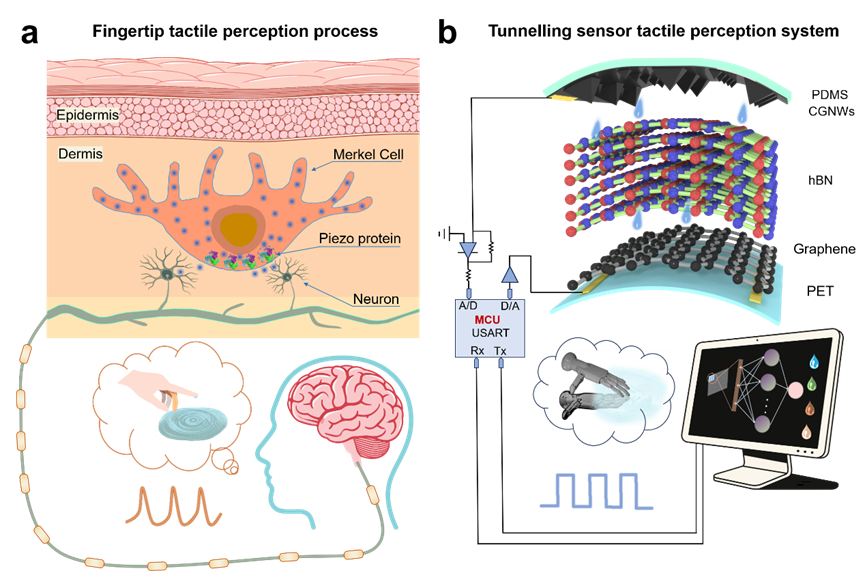

When intelligent robots perform ultra-precise manipulation tasks in complex environments, distinguishing subtle pressures through tactile sensing (e.g., in fluid environments) remains a critical technical bottleneck. Although several high-sensitivity flexible tactile sensors have been reported, their pressure resolution in practical applications still falls short of requirements due to inherent noise limitations in flexible sensors.
Recently, the Robotics Technology and Systems Center at the Chongqing Institute of Green and Intelligent Technology, Chinese Academy of Sciences (CAS), published a paper titled “Superlow-Noise Quasi-2D Vertical Tunneling Tactile Sensor for Fine Liquid Dynamic Recognition” in the journal ACS Nano. Inspired by the Merkel cells in human fingertips, the research team developed a conformal graphene nanowalls-hexagonal boron nitride-graphene (CGNWs-hBN-Gr) quasi-2D vertical tunneling tactile sensor. This design mimics the biological mechanogated ion channels of pizeo2 proteins using hBN tunneling channels, achieving macroscopic regulation of interlayer tunneling currents through micro-nano multiscale force-sensitive interfaces (Fig. 1). Additionally, the hBN capping layer and tunneling effect effectively suppress trap charges, reducing the 1/f noise of the device. Experimental data show that the sensor exhibits a sensitivity of up to 1.99 ×106 kPa-1, a noise power spectral density of 2.2×10-24 A2/Hz at 10 Hz, a noise-equivalent pressure (NEPr) as low as 7.96 ×10-3 Pa, and a signal-to-noise ratio of 68.76 dB. The team established a robotic fingertip liquid recognition system and successfully captured microdynamic features during liquid contact by comparing COMSOL simulations with experimental data. Combined with a Transition-Aware Contextual Attention Network (TacAtNet) model, the system achieved a recognition accuracy of 98.1% for different solutions and even varying concentrations of the same solution (e.g., alcohol at 0%, 25%, 50%, 75%, and 99%). This technology significantly enhances robots’ perception capabilities in complex environments and provides a guarantee for next-generation robotic applications.
Ph.D. candidate Guanyin Cheng from the Chongqing Institute of CAS is the first author of the paper, and Researcher Dapeng Wei is the corresponding author. This work was supported by National Natural Science Foundation of China, National Key Research and Development Program of China, and the Project of Chongqing Science and Technology Bureau.

Figure 1. Bionic sensing structure and tactile sensing process. (a) Human fingertip tactile sensing system. (b) Structure and sensing process of the quasi-2D vertical tunneling tactile sensor.